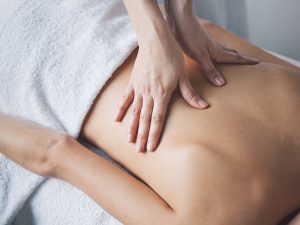WHAT TO EXPECT DURING YOUR FIRST MASSAGE SESSION
by Eric Stephenson
If you’re anything like me, the anticipation of receiving a massage can feel a lot like the build up to going on a great vacation.

But instead of a long weekend, you’re in for an afternoon of relaxation with significant health benefits, ranging from decreased back pain to improvement in symptoms of depression and anxiety.
It’s a welcome break from the world.
But it does require the all-important first step: booking the appointment.
As obvious as the benefits are, both physically and mentally, booking your first appointment can be a bit nerve-wracking, especially if you don’t know what to expect. Will the massage therapist be a man or a woman? What should you do if you feel uncomfortable?
A common misconception is that massage is a one-size-fits-all therapy. Many people don’t understand that it’s supposed to be an extremely customizable and personalized experience, based on individual needs and comfort level.
So, what should you expect during your first massage session—and how can you make sure the experience is as enjoyable as possible?
Communicate Before, During & After the Session
Before your appointment begins, your massage therapist should take a few minutes to get to know your health history, determine how your body is feeling to you, and discuss what you’d like to get out of the session.
During this discussion, it’s your opportunity to communicate your needs, concerns, and any areas you prefer to have specifically worked with and conversely, the areas you would like the therapist to avoid.
If you’ve never had a massage before, you may discover you like, dislike or need to adjust something during your session. Always be sure to speak up and let the massage therapist know what you need.
Whether it’s more pressure, less music or additional draping, there should always be an open line of communication between you and your therapist to make you as comfortable as possible, at all times.
Understand the Power Differential
It’s important to be aware of the power differential that can take place once you’re on the table.
Many times, people don’t speak their needs as clearly when they are on a massage table, and a clothed professional is standing over them. It can inhibit a lot of people from communicating their needs on pressure, table temperature, or if the draping doesn’t feel comfortable.
The good news is, massage therapists are trained to use leading questions to help you feel at ease.
For example, in terms of asking about pressure, rather than the therapist asking how the pressure is on the table, they should ask you whether you’d like more, less or the same amount of pressure, so you can articulate what you want. This feedback is important for you and for them throughout the massage session.
Like communication in any new relationship, it’s normal to feel a bit awkward communicating with your massage therapist at first. Rest assured that for the therapist, this feedback and information is a normal part of their service, so that may take some of the apprehension out of asking for what you need.
With time and experience, you should find yourself becoming more and more at ease.
Know What you Like.
There are several different approaches to massage. Swedish massage, sometimes also referred to as sports massage, tends to be more of a gliding massage that uses oil-based lubricants, so the therapist is actually gliding and kneading the tissue.
Other types of massage, such as myofascial massage, might include static holding of the skin and a light stretch that would include little or no lotion on the hands, so it’s actually engaging the tissue in a more direct way without the glide.
Then you have various forms of bodywork like shiatsu, where there is digital compression being applied from the thumbs without any lotion or oil, as well as Thai massage, where you’re fully clothed during the massage.
There are many approaches and modalities of massage. So, it depends on you and what type of touch you personally find meaningful and helpful as well as gives you the results you are seeking.
Face Up or Face Down?
Whether you are face up or down, you can expect to always be as comfortable as possible. There are many ways that a massage therapist can adjust, using pillows or bolsters, to make you more comfortable, depending on your body size and range of motion in your neck and shoulders.
When you’re face up, it’s the facial and head massage, and kneading of the arms, feet and legs. When you’re face down, it’s more of a full-back experience.
Something to look out for when you are face down is that your sinuses may act up after approximately 15 to 20 minutes.
It’s certainly okay to turn your head to the side or come down on the table to be in a traditional belly position, with the pillow at your head. If you’re uncomfortable, or if you’re feeling pressure on your sinus cavity or forehead from the cradle, just communicate with your therapist and they will adjust you.
More often than not, they will notice you moving around before you even realize you’re uncomfortable and can adjust your position.
Draping Keeps You Safe & Secure
Ultimately, there are some main reasons why you are draped with a sheet at all times during a massage. The first is for protecting your modesty, the second is for warmth and comfort and finally, the drape provides a physical boundary between client and therapist, defining where the therapist’s hands may touch and where they can’t.
Dressing down to your personal comfort level should be the instruction from any professional massage therapist and that will look different for every person.
Regardless of how much clothing you choose to take off or keep on, the drape should only uncover the area being worked with and should always cover the genitals and breast tissue.
Ultimately, proper draping should make you feel safe and comfortable, and you should never question if you are being exposed. This is typically the biggest fear for clients, but a safe drape will leave no question in your mind that the parts of yourself that you want covered are covered, and the only part of your body that isn’t covered is the part that they are working on at that moment.
What to Do After the Massage
Your massage therapist should give you a professional recommendation at the conclusion of your massage session. These recommendations could include how often you should get a massage, benefits of regular massage as well as a piece of self-care you can take away from the session to increase the cumulative effects of your massage.
Examples of this might include rolling a golf ball under your foot, a particular stretch for a muscle group or paying attention to how you use your arms while driving.
Massage usually isn’t a one-and-done therapy, and it’s important to know what you should do between sessions to enhance the positive effects.
Overall, while the massage therapist is the expert on massage, you’re in control of what happens during the session.
A good massage should be enjoyable, meaningful and helpful. It’s important you feel empowered to ask for what you need, from the amount of clothing you leave on, to the pressure you want, to the types of oil and lotion you prefer or the temperature on the table.
You know your body better than anyone, and by communicating that with your therapist, you will have the most beneficial experience possible.
Hopefully, that experience is one you will want to repeat over and over again.
Original Article by Eric Stephenson found here: massagemag.com
Book Your Massage In Salt Lake City @ Zen Massage

